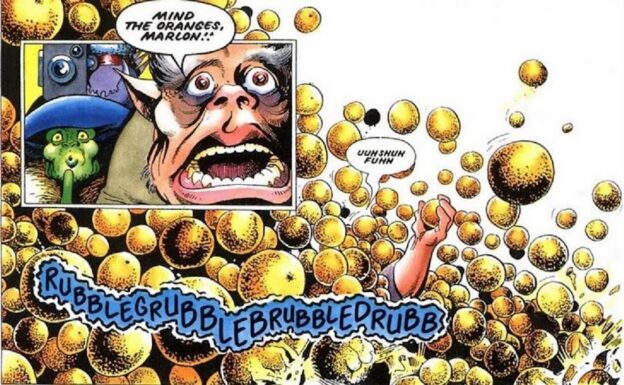In the violently wacky and vehemently whimsical world of Alan Moore’s characters, DR and Quinch, known for their satirical and bizarre escapades, a stand-out moment is the death of the faux Marlon Brando character. Cleverly bridging the gap between their universe and that of classic Hollywood cinema of the decade before.
During one of their wild intergalactic adventures, Quinch throws out a line that brilliantly encapsulates this connection “Mind the oranges, Marlon!”. This phrase, delivered with their typical irreverent humour, is not just a random quip but a direct satirical reference to Marlon Brando, the iconic actor from “The Godfather.” It cleverly links the use of oranges in Coppola’s film to their chaotic narrative, merging two vastly different worlds through a shared cinematic trope.
Building on this humorous nod to “The Godfather” by DR and Quinch, let’s transition to the more sombre and profound context in which oranges are used in Francis Ford Coppola’s masterpiece. In “The Godfather,” adapted from Mario Puzo’s novel, the orange is more than just a prop; it becomes a symbol laden with foreboding and significance. This film, a cornerstone of the “New Hollywood” movement, known for its darker, more complex themes, uses oranges to add a layer of symbolic depth to its narrative.

The oranges in “The Godfather” are not mere set decorations; they are meticulously placed to foreshadow impending tragedy and doom. This intricate use of symbolism contrasts sharply with the satirical and light-hearted reference made by DR and Quinch, showcasing the versatility and enduring influence of this cinematic motif.
Oranges as Harbingers of Misfortune and Catastrophe in ‘The Godfather’
Throughout the entirety of “The Godfather,” the presence of oranges is a recurring visual cue, consistently preceding moments of death or unexpected calamity. This pattern is subtly established and meticulously followed, creating an undercurrent of foreboding each time an orange appears on the screen.

For instance, a critical scene unfolds when Vito Corleone is casually purchasing oranges on the street. This seemingly innocuous act is abruptly transformed into a moment of violence as he is ambushed and shot. In a poignant visual, the oranges he was holding scatter across the pavement, symbolizing the sudden disruption of order and the fragility of life.

This motif is further reinforced in another key sequence involving Jack Woltz. In the scene leading up to the infamous horse’s head revelation, oranges are strategically placed on the dinner table where Woltz dines with Tom Hagen. The presence of oranges here acts as a subtle harbinger of the shocking and grotesque twist that is about to be revealed, heightening the sense of impending dread.
Perhaps the most poignant use of this motif occurs near the film’s conclusion. Vito Corleone, in a serene and domestic setting, is shown peeling an orange and playfully using the rind to amuse his grandson. This tender moment is laden with dramatic irony, as the audience, now aware of the ominous association of oranges, senses the approach of another tragedy. Vito’s eventual passing, surrounded by his family, is marked by a stark contrast between the peaceful setting and the underlying tension created by the presence of the orange, culminating in a powerful and memorable cinematic moment.
Unintended Symbolism: Oranges as a Visual Contrast in ‘The Godfather’s’ Somber Scenes”
But the irony lies in the original intention behind this motif – as noted by Harlen Lebo in his book, “The Godfather Legacy,” the oranges were simply meant to add a splash of colour to the sombre sets.

Production designer Dean Tavoularis didn’t imbue them with symbolic weight; it was a happy coincidence that they came to represent so much more. The oranges were simply another carefully chosen complement to otherwise somberly dressed sets. ‘We knew this film wasn’t going to be about bright colours, and oranges make a nice contrast,’ said Tavoularis. ‘I don’t remember anybody saying, Hey, I like oranges as a symbolic message.’ “
Influence of ‘The Godfather’s’ Orange Motif in Cinema and Television
The legacy of the oranges in “The Godfather” has transcended the film itself, influencing other iconic crime dramas.

From the near-death experience of Tony Soprano in “The Sopranos”, where he buys orange juice just before the attempt on his life.

And tense moments in “Breaking Bad”, where oranges appear over Ted Benneke as he breaks his neck, and Walt’s neighbour, Carol, drops her grocery bag and oranges roll out when she sees him return.

To the foreshadowing of the death of Omar Little in “The Wire” and the shootout in “Point Break,” the orange motif continues to be a subtle nod to impending danger and the inescapable presence of death in the crime genre.
And the latest blockbuster example is Brad Pitt’s “Bullet Train”, with the death of (the daughter of) “The White Death”.
Thus, what began as a simple aesthetic choice in “The Godfather” has ripened into a rich and enduring symbol in cinematic storytelling.
